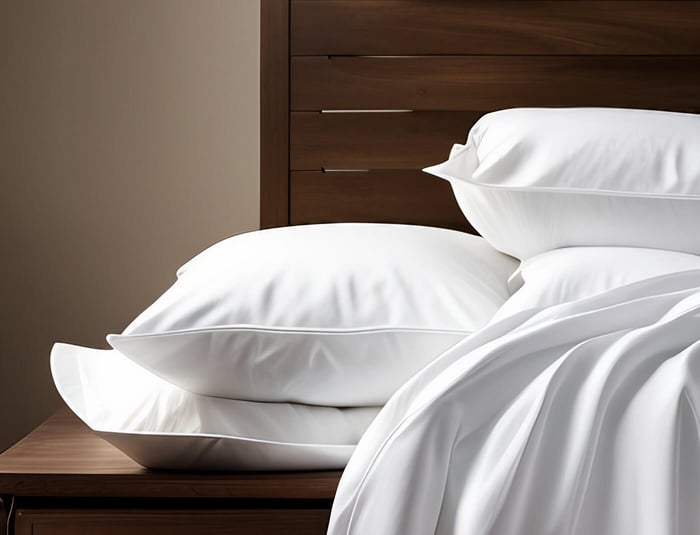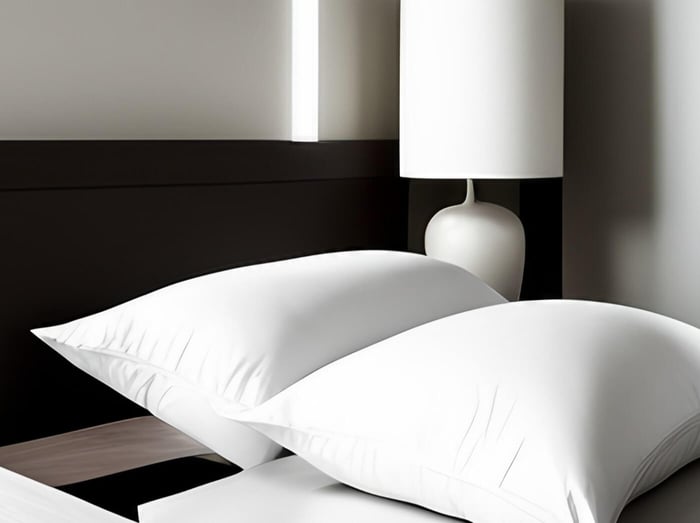How do you wash pillowcases?
Washing pillowcases is a relatively straightforward process. Here are some general guidelines to follow:
Always check the care label: Before washing your pillowcases, check the care label. The label will provide specific instructions for washing and drying. Follow any guidelines or recommendations mentioned.
Sort and separate: Separate your pillowcases from other laundry items. Sorting them by color and fabric type is a good practice to avoid color bleeding or fabric damage.
Pre-treat stains: If you notice stains on the pillowcases, pre-treat them before washing. Apply a small amount of stain remover or you can pour liquid detergent directly to the stained area, gently rub it in, and let it sit for a few minutes before washing.
Select appropriate settings: Choose the appropriate water temperature and wash cycle for your pillowcases. In general, a warm or cool water setting, and a gentle or delicate cycle are suitable for most pillowcases. Again, refer to the care label for specific instructions.
Use mild detergent: Use a mild laundry detergent that is suitable for your pillowcase fabric. Avoid using bleach or harsh chemicals unless stated otherwise on the care label.
Load and wash: Place the pillowcases in the washing machine, ensuring that you don't overload the machine. Too many pillowcases can prevent proper cleaning and rinsing. Wash them according to the selected settings.
Dry properly: After the washing cycle is complete, remove the pillowcases from the machine promptly. Check the care label to determine if they can be tumble dried or if air drying is recommended. If using a dryer, use a low or medium heat setting. Air drying pillowcases can help preserve their quality and minimize shrinking.
Iron or steam (if needed): If your pillowcases are wrinkled after drying, you can iron them using a low heat setting or use a handheld steamer to remove wrinkles.
Remember to always check the specific instructions on the care label for your pillowcases, as different fabrics may have different requirements.
Different Types of Pillowcases and their Benefits
Pillowcases play an important role in enhancing sleep quality, maintaining skin health, and contributing to the aesthetic appeal of a bedroom. Various types of pillowcases are available, each offering unique benefits based on their material, design, and function.
Cotton pillowcases are among the most popular due to their natural, breathable, and hypoallergenic properties. Cotton is soft, durable, and easy to care for, making it a practical choice for everyday use. Its breathability ensures that heat and moisture are efficiently dissipated, keeping the sleeper cool and comfortable throughout the night. Cotton pillowcases are also versatile, available in various weaves such as percale, which is crisp and lightweight, and sateen, which is smooth and slightly lustrous. These different textures cater to individual preferences for feel and comfort.
Silk pillowcases are renowned for their luxurious feel and numerous beauty benefits. Silk is a natural protein fiber that is gentle on the skin and hair, reducing friction and minimizing the occurrence of wrinkles and hair breakage. The smooth surface of silk pillowcases helps retain skin moisture and allows hair to glide smoothly, preventing frizz and tangles. Silk is also hypoallergenic and resistant to dust mites, making it an excellent choice for those with allergies or sensitive skin. Although more expensive and requiring delicate care, the benefits of silk pillowcases can be well worth the investment for those seeking to enhance their beauty sleep.
Satin pillowcases, often made from polyester or a blend of synthetic fibers, offer a more affordable alternative to silk while still providing similar beauty benefits. The smooth, glossy surface of satin helps reduce friction against the skin and hair, preventing creases and split ends. Satin pillowcases are also cool to the touch, which can be particularly beneficial in warmer climates or for individuals who tend to overheat at night. Easy to care for and available in a wide range of colors and patterns, satin pillowcases combine practicality with aesthetic appeal.
Linen pillowcases are prized for their natural texture, breathability, and durability. Linen, made from the flax plant, has excellent moisture-wicking properties and is highly breathable, making it ideal for hot sleepers and humid environments. The fabric becomes softer with each wash, offering long-term comfort and a relaxed, casual look. Linen pillowcases also have a unique texture and aesthetic that can add a touch of rustic elegance to a bedroom. Additionally, linen is hypoallergenic and resistant to bacteria and fungi, promoting a healthy sleep environment.
Bamboo pillowcases are gaining popularity for their eco-friendly properties and softness. Bamboo fabric is derived from bamboo fibers and is known for being exceptionally soft, breathable, and moisture-wicking. These pillowcases are also naturally hypoallergenic and resistant to dust mites, making them suitable for people with allergies or sensitive skin. Bamboo pillowcases have a silky feel similar to that of high-quality cotton or silk but are often more affordable. Their temperature-regulating properties help keep sleepers cool in summer and warm in winter, providing year-round comfort.
Microfiber pillowcases, made from finely woven synthetic fibers, are known for their affordability, durability, and low maintenance. Microfiber is resistant to wrinkles and stains, making it an easy-care option that retains its appearance over time. The tightly woven fibers create a soft and smooth surface that is gentle on the skin. Microfiber pillowcases are also effective at wicking away moisture, keeping sleepers dry and comfortable. While they may not offer the same luxurious feel as natural fibers, their practical benefits make them a popular choice for everyday use.
Organic pillowcases, made from materials like organic cotton or bamboo, are designed with environmental sustainability and health in mind. These pillowcases are free from harmful chemicals and pesticides, making them a safe choice for people with chemical sensitivities or those looking to reduce their environmental footprint. Organic pillowcases provide the same benefits as their non-organic counterparts, such as breathability, softness, and hypoallergenic properties, while also supporting eco-friendly practices.
Flannel pillowcases, typically made from brushed cotton, are ideal for colder climates and winter months. The brushed surface of flannel provides a cozy, warm feel that is perfect for retaining heat and providing comfort on chilly nights. Flannel is also soft and durable, making it a practical choice for those seeking warmth and comfort.
The type of pillowcase you choose can significantly impact your sleep quality, skin health, and bedroom aesthetics. Whether you prioritize the luxurious feel of silk, the practical benefits of cotton, the eco-friendliness of bamboo, or the warmth of flannel, there is a pillowcase to suit every preference and need. Understanding the unique benefits of each type can help you make an informed decision, ensuring that your choice enhances your overall sleep experience.
Below, is break down of different types of pillow cases:

Direct Textile Store ships to all US states, including Alaska and Hawaii, US Territories, Canada, Puerto Rico, St. Thomas, and St. Croix.
About the Author
Haley Bridges, Marketing Assistant at Direct Textile Store
Haley Bridges has served as Marketing Assistant at Direct Textile Store, where she specializes in hospitality linens, uniforms, and bulk textile solutions. She works closely with hotels, restaurants, and healthcare facilities to match them with durable, high-quality products that balance both performance and value. Haley's expertise in textile sourcing and merchandising strategy helps businesses make confident purchasing decisions while staying ahead of industry trends.
If you need assistance, contact Direct Textile Store Customer Service at 800-615-5822





